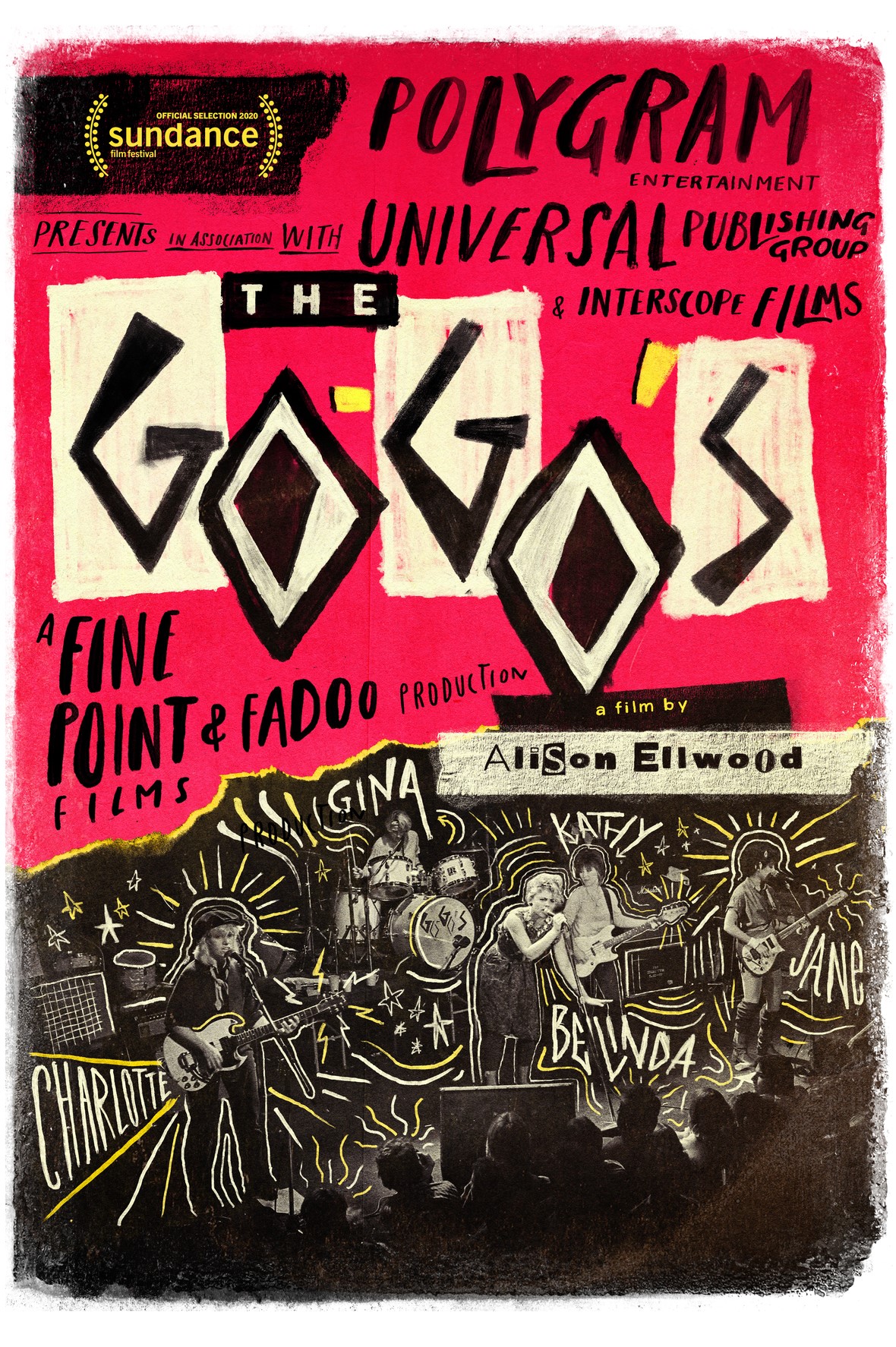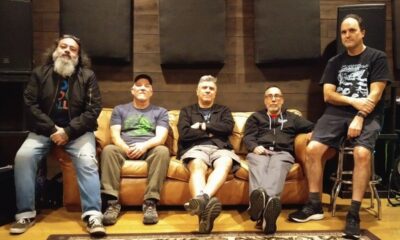Alternative/Rock
‘The Go-Go’s’ by Alison Ellwood [Documentary Review]

The appearance of this DVD documentary chronicling the life and times of history’s sunshiniest and most rosy-cheeked girl group comes at a strange intersection for your humble narrator and goes a long way in demonstrating that The Go-Go’s weren’t exactly history’s sunshiniest and most rosy-cheeked girl group. The Go-Go’s collides with two of the many books that have been taking up space on my nightstand as of late: All I Ever Wanted, which is bassist Kathy Valentine’s autobiography, and Spray Paint the Walls, the authoritative tome detailing the history of Black Flag.
The connection between this film – which tore it up on the contracted Sundance festival and with critics last summer – and book number one is obvious. Valentine may have been the last member drafted into the Go-Go’s lineup that the general public knows best, but she appears to have played an unheralded role in managing the various personalities as a middle-ground peacekeeper, not to mention her blossoming as a songwriter during the band’s latter days. She and drummer Gina Schock were the pair who strove to keep the band alive towards the end, before dissolution was foisted upon them by guitarist Charlotte Caffey and vocalist Belinda Carlisle.
The connection to Spray Paint the Walls is probably a bit more surprising, unless you grew up in the late ‘70s L.A. punk scene, or have previously dug into the band’s history. Upon reading about the adventures of Greg Ginn and the Flag, the Go-Go’s name would come up now and again in descriptions of the bands and participants in the early southern Cali punk scene. “Huh,” I thought to myself, “that’s surprising, but makes sense. I’ll have to take note of that next time I throw on Beauty and the Beat.” Yeah, yeah, yeah, in addition to all the mean-looking n’ scary-sounding underground metal, ear-shredding noise and avant-garde jibber-jabber I’ve been punishing my family and neighbours with since the early ‘80s, I’ve always enjoyed the Go-Go’s because only black-hearted scoundrels can deny a solid hook, an element these five ladies knew their way around. On the flip side of that comment is the fact that the relationship between my historical knowledge of the band and how big a fan I was was inversely proportional.
The story of the Go-Go’s starts in the heart of the L.A. punk scene and The Go-Go’s goes straight to the heart of the matter with band member interviews – including their original rhythm section (drummer Ellisa Bello and bassist Margot Olavarria) – discussing how they discovered punk, the scene and the acceptance of a posse of double x-chromosome sporting power punk rockers in the days of bloated classic rock, polished AOR, skilled shredders and prodigious professionalism. It shouldn’t come as any surprise that a band with an initially limited skill-set like the Go-Go’s would find home in the punk scene. What is surprising is how that band of rookies became residents at the top of the Billboard charts within three years.
The footage and photos comprising the first third of the documentary are a treasure trove. Included are grainy video of early shows, candid backstage, rehearsal and hanging out photos and pre-band pics as they navigated the graffiti-strewn hallways and creeping black mould bathrooms of early punk venues. There are photos of them in the crowds at various shows (including the final stop on the Sex Pistols only US tour, described by guitarist Jane Wiedlin as a letdown) and plenty of show flyers. Someone out there is sitting on a gold mine of memorabilia that would give the curator at the Rock and Roll Hall of Fame a hard/wide-on when it comes time for the band to be inaugurated (that it hasn’t happened yet is addressed, and as you might imagine, everyone agrees the omission thus far is a massive oversight).
The above mentioned early-years content is presented via rapid-fire editing alongside animated representations of significant events and interview clips with all involved, including their inner circle of friends, fellow musicians and management types. And of course, once they started clawing their way out from under the limits of punk, it seemed everyone in the band’s proximity was either carrying some form of camera or had one of those sputnik-sized early video cameras on their shoulder as personal footage shares more space with all the videos, broadcast TV appearances, pro-shot concert footage and whatnot. As upward headway was being made, the viewer gets to pay witness to both Olavarria’s growing opposition to the pop direction and all the triumphs and trappings that followed their skyrocket to success.
Much of what follows is the Go-Go’s experiential take on the age-old story of success corrupting and playing havoc with the lives of the creators: shitty managers, exhausting non-stop touring schedule, record company deadlines and demands, writer’s block, growing resentment over financial inequity, health scares, drug addiction, Wiedlin quitting (which in hindsight was entirely avoidable) and everything else all magnified by the fact that the Go-Go’s were the first all-female band to write their own songs, go to number one doing so and that their achievement came during the age of video killing the radio star. With MTV becoming a more dominant force, video cameras were ubiquitous and what’s revealed is a disconnect within and between the ranks – they are visibly annoyed at vapid VJ interview questions and are much more judicious in the film about their hatred of the video for “Our Lips are Sealed” than Valentine is in her book. But to both creator and consumer, the wealth of curated footage helps tell the story without the visual repetition you often see in other rock docs.
Two major points stand out as revelatory as the film ticks along. First, Carlisle’s public position as frontwoman, her canoodling with celebrity and post-Go-Go’s success was in direct contrast to her creative value to the band. Carlisle may have got the glory, but if it wasn’t for Gina Schock’s military-like work ethic and the hook writing team of schooled musician Caffey, and self-taught natural Wiedlin (with Valentine contributing more than what she’s often publicly recognized) then who knows what might have happened. Secondly, The Go-Go’s also reveals how their outbound California good-girl image existed in contrast to a darkness that was never far from the surface. The quintet partied, drank, consumed drugs and polluted their innards with the best of them. They were a travelling cavalcade of inside jokes and toilet humour references that always seemed one line or bottle away from self-destruction. Witness the infamous “sex tape” (which is more a super-blurry video of a wasted roadie trying to stroke himself hard while the band talks a bunch of drunken blather than it is a sex tape) and Caffey’s misadventures during the Rock in Rio Festival: as it’s deadpanned in the doc, “Ozzy threw Charlotte out of his dressing room. That’s pretty fucking bad!”
Essentially, while the Go-Go’s will forever be singled out for their firsts, they suffered the same fate as so many other successful bands: a bunch of early 20-somethings writing great songs, but poorly handling all that comes with being thrust into the spotlight. Admittedly, they did not do very well as the infighting, cutthroat business stuff, substance abuse, crumbling relationships and all-around toxicity split the seams and did so even going into the Vacation album and long before 1984’s Talk Show. But as much as The Go-Go’s highlights how the highest highs are often quickly followed by the lowest lows in the music game, this film’s light at the end of the tunnel comes during the last ten or so minutes which documents the five of them writing for the first time together since 2000 or so at the Whiskey in Hollywood, an old haunt of theirs. Survival, coming full circle, the close calls in the battle between art and commerce and all those sappy clichés may have been unavoidable, but the Go-Go’s story is compelling, interesting and their twisted take on a familiar rock and roll tale is matched by director Alison Ellwod’s presentation style.
Director: Alison Ellwood
Producer: Trevor Birney, Eimhear O’Neill, Corey Russell
Production Company: Polygram Entertainment
Featuring: The Go-Go’s, Charlotte Caffey, Belinda Carlisle
Release Date: July 31, 2020
Run Time: 98 minutes
-

 Alternative/Rock6 days ago
Alternative/Rock6 days agoThe Warning Shake the Foundations of a Sold-Out Leeds Stylus [Photos]
-

 Music2 weeks ago
Music2 weeks agoTake That (w/ Olly Murs) Kick Off Four-Night Leeds Stint with Hit-Laden Spectacular [Photos]
-

 Alternative/Rock6 days ago
Alternative/Rock6 days agoThe V13 Fix #011 w/ Microwave, Full Of Hell, Cold Years and more
-

 Alternative/Rock2 weeks ago
Alternative/Rock2 weeks agoThe V13 Fix #010 w/ High on Fire, NOFX, My Dying Bride and more
-

 Features2 weeks ago
Features2 weeks agoTour Diary: Gen & The Degenerates Party Their Way Across America
-

 Indie6 days ago
Indie6 days agoDeadset Premiere Music Video for Addiction-Inspired “Heavy Eyes” Single
-

 Folk6 days ago
Folk6 days agoKatherine Perkins Strikes the Right Tone with Her “Hold On” Music Video Premiere
-

 Country1 week ago
Country1 week agoBrooke Ashton Chats About Her “Someone” Single, Creative Process, and More!












